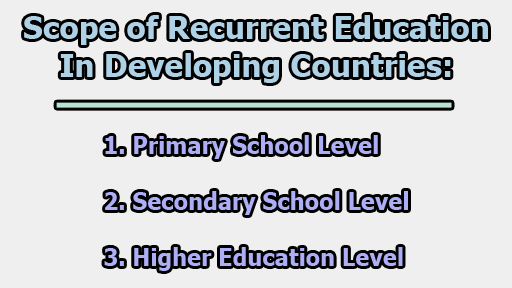Scope of Recurrent Education in Developing Countries:
The scope of recurrent education in developing countries is a complex and multifaceted topic. While much of the evidence and research on recurrent education originates from more developed countries, the lessons learned from these countries can still be applied to address specific issues encountered in developing nations. The relevance of recurrent education programs can be considered at three levels of the education pyramid: primary school level, secondary school level, and higher education level.
1. Primary School Level:
1.1 Deferred Entry into Primary School: One proposal that has been considered in the context of recurrent education in developing countries is to defer the age of entry into government-funded primary schools until the age of 11 or 12. This approach is based on several key pieces of evidence:
- Quick Learning in Early Adolescents: Research indicates that early adolescents (children aged 11 or 12) tend to grasp educational material more quickly than younger children. This observation suggests that delaying primary education might lead to more efficient learning.
- Arithmetic Proficiency: Studies have shown that pupils who enter school at the age of 7 learn as much arithmetic by the age of 13 as children who enter school at a younger age. This demonstrates that a delay in school entry may not compromise mathematical proficiency.
- Language Learning: Vocabulary and reading comprehension in a second language are achieved almost twice as fast by 12 to 15-year-olds compared to 6 to 11-year-olds. This finding implies that postponing the start of primary education might be conducive to language acquisition.
1.2 Human Capital and Health Considerations: Postponing primary education until the age of 11 or 12 aligns with reducing the impact of high child mortality and morbidity rates between the ages of 5 to 10. As children grow older, mortality and morbidity rates decrease, reaching a minimum in the early teens. By deferring primary education, it is possible to save a significant amount of human capital that might otherwise be lost due to health issues.
1.3 Equity Concerns: While the idea of delaying primary education has potential advantages in terms of learning efficiency and health considerations, it raises concerns about equity. Postponing school entry until 11 or 12 might disadvantage children from economically disadvantaged backgrounds who could potentially contribute to their family’s income at an earlier age. This approach might inadvertently deny primary schooling to the poorer segments of the community.
1.4 Economic Implications: Another factor to consider is the economic impact of deferring primary education. Postponing the start of formal schooling could lead to a delay in human capital development, which might have economic implications in the long term. The foregone earnings associated with primary schooling are relatively low, which suggests that prolonged deferment of primary schooling might not be a sound economic decision.
1.5 Adult Literacy Programs: In the context of recurrent education, there’s a question of whether educational resources should be allocated to adult literacy programs. This issue remains a subject of debate, with no definitive answer due to the complexity of the matter. The development value of literacy teaching in the underdeveloped world depends on various factors, including the nature of the curriculum and the practicality of implementing functional literacy programs.
Recurrent education at the primary school level in developing countries involves a nuanced assessment of when children should start formal schooling. While there are potential benefits related to learning efficiency and health, equity concerns and economic implications must be carefully considered. Decisions should be made with a focus on optimizing educational outcomes and overall societal development while addressing the unique challenges faced by developing nations.
2. Secondary School Level:
2.1 Vocational Education: At the secondary school level, recurrent education in developing countries often involves vocational education. This level of education aims to provide students with practical skills and knowledge that can prepare them for the workforce. However, there are several considerations in this context:
- In-School vs. In-Service Learning: Some vocational skills are best acquired through in-service learning or on-the-job training, rather than traditional classroom education. These skills are often better developed through practical experience and may not be effectively taught within a school environment.
- Prohibitive Costs: The costs associated with in-school teaching and learning of certain competencies can be prohibitively high. This is especially relevant in developing countries where resources are limited, and traditional vocational education might not be the most cost-effective option.
- Obsolescence: Vocational education faces the challenge of skills obsolescence. In rapidly evolving fields, skills learned in the formal schooling system may lag behind current industry practices. As a result, vocational education may not adequately prepare students for the job market.
2.2 Employment Outcomes: Graduates of secondary vocational schools in developing countries often encounter high unemployment rates. Despite a growing demand for technical and vocational skills, these graduates may struggle to find suitable employment. This mismatch between education and employment opportunities raises questions about the effectiveness of vocational education at this level.
2.3 Economic Considerations: The economic argument for postponing vocational education, or even discouraging it, stems from the relatively low foregone earnings associated with such education. In other words, the potential income loss from delaying vocational training may not justify the investment in the long term.
2.4 On-the-Job Learning: In developing countries, on-the-job learning or learning by doing is a prevalent method for individuals to acquire vocational skills. This form of learning occurs throughout a person’s working life and is crucial for skill development. However, the absence of structured on-the-job learning opportunities can have adverse effects on individuals’ skills, morale, and overall well-being.
2.5 Unemployment and Skill Decay: Prolonged periods of unemployment, which are more common in developing countries, can have negative consequences for vocational skills. Skills decay and become less relevant when individuals are unable to find employment. This exacerbates the problem of unemployment among vocational school graduates.
Recurrent education at the secondary school level in developing countries presents challenges related to the effectiveness of vocational education. Policymakers and educators must weigh the costs and benefits of vocational education programs and consider the dynamic nature of the job market. The emphasis should be on aligning education with real-world employment opportunities to ensure that students are adequately prepared for the workforce. Additionally, promoting on-the-job learning and addressing issues of skill decay during periods of unemployment are important aspects of recurrent education at this level.
3. Higher Education Level:
3.1 Recurrent Education Programs: At the higher education level in developing countries, recurrent education programs often take on unique characteristics to address the evolving educational needs of the population. These programs may include the following key features:
- Secondary Education as Terminal: Some recurrent education programs are designed with the assumption that secondary education will be terminal for most students. This means that after completing secondary education, the majority of students will transition into work or vocational training rather than pursuing traditional university education.
- Aptitude Testing and Work Experience: Recurrent education programs may incorporate aptitude testing and consider evidence of work experience and community service to select students. This approach aims to match individuals with programs that align with their abilities and interests.
- Quota System and Future Demand: These programs may utilize a quota system that is determined based on projections of likely future demand for specific skills or fields of study. This helps ensure that resources are allocated efficiently.
3.2 Benefits of Recurrent Education at the Higher Level: Recurrent education at the higher level offers several potential benefits for individuals and society in developing countries:
- Increased Motivation for Study: By reducing the risk and uncertainty associated with choosing a specialization early, recurrent education can increase students’ motivation for further study.
- Exposure to the World of Work: Students who participate in recurrent education programs often gain experience in the world of work. This exposure can improve their attitudes toward further education and help them make informed career decisions.
- Exploration of Alternative Careers: Recurrent education allows students to experiment with life styles and consider alternative career paths that may not require traditional higher education.
- Relevant Work Experience: Through recurrent education, students have the opportunity to acquire work experience that is directly relevant to their future occupations. This practical experience can be a valuable asset in the job market.
3.3 Efficiency and Equity Arguments: The efficiency argument for postponing higher education in recurrent education programs is robust. Delaying specialization and providing opportunities for work experience can result in a more efficient and well-informed workforce.
From an equity perspective, such postponement can offer late starters a more equal chance to access higher education. It helps reduce the disparities in educational opportunities among individuals from different backgrounds.
3.4 “Sandwich Courses”: Some recurrent education programs in developing countries adopt the model of “sandwich courses” for young people. These programs alternate between education and work, providing a balance that is cost-effective and attractive, especially when compared to full-time higher education.
3.5 Challenges with Older Individuals: While recurrent education programs are effective for young people, they may present challenges when targeting older individuals. The “investment in older individuals” argument is relatively weaker in developing countries due to:
- Higher Morbidity and Mortality Rates: Older individuals in these countries often have significantly higher morbidity and mortality rates, reducing the potential societal benefits of investing in their education.
- Economic Constraints: Developing countries may have limited financial resources to invest in recurrent education for older individuals.
- Equity Considerations: Achieving a slight increase in equity between generations may come at a high cost for developing countries, making it less financially viable.
Recurrent education at the higher education level in developing countries involves tailoring programs to meet the specific needs of the population. These programs aim to increase motivation for study, provide exposure to the world of work, and offer relevant work experience. The efficiency and equity arguments support the postponement of higher education in many cases. “Sandwich courses” and similar approaches offer cost-effective options, especially for younger individuals, while challenges exist when targeting older learners due to health and economic constraints. Policymakers should carefully consider these factors when designing and implementing recurrent education programs at the higher education level.
In conclusion, recurrent education in developing countries presents opportunities and challenges at various levels of the education system. Policies and programs should be tailored to the specific needs and circumstances of each country, taking into account factors such as equity, economic considerations, and the unique demands of the labor market. The types of recurrent education programs discussed, including those connected to “infant training industries,” secondary school vocational education, and higher education postponement, offer potential solutions to address the evolving educational needs of developing nations.

Former Student at Rajshahi University










